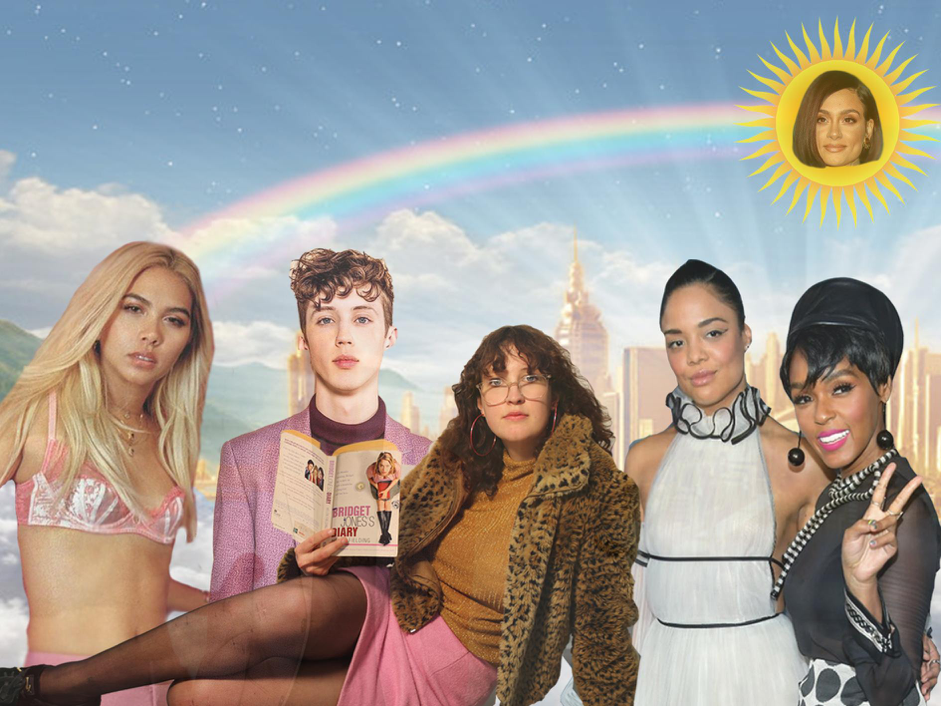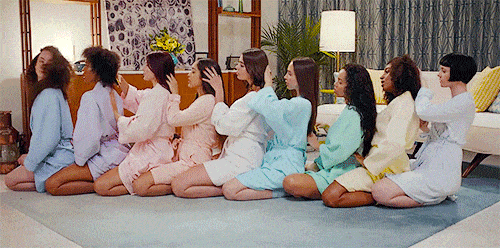Belief and the Queer Music Video in Contemporary Pop

I’m at the club on a Sunday night after playing a show as one half of Entirely Kylie, a Kylie Minogue cover band I started with a friend from uni about a year ago. My date and I are dancing and she whisper-yells above a bizarre techno remix of John Farnham’s ‘You’re The Voice’, “I just realised Kylie and Savage Garden both have songs about believing”. I’m shook. And so I do what any millennial with aspirations of a queer utopian academia would do and urgently keysmash a new iPhone note: ‘PhD topic: belief in queer pop anthems’. It’s a realisation which perhaps justifies why I am drawn to re-enacting songs which challenge the dominant trope that tragedy is an inherent and expected part of queer content. In my own performance practice, I look at pop icons and music prevalent within queer and gay clubs, and use re-enacting as an articulation of femme presence and the power of being present and proud. As an #emergingqueer, I think a lot about representations of queer life, particularly the narratives of pop music videos, and the role they play as a media form that floats between video art and gratuitous choreographic documentation.
I start research with ostensibly the most reliable and accessible research resource for lazy people - Google. I’m scrolling through a search query of ‘gay music videos’ on the Huffington Post Website, because I’m a feminist, and Noah Michaelson’s ‘WATCH: Is This The Gayest Music Video Ever?’ queer-clickbait grabs my attention. The subtitle reads: “Hot Chip’s ‘Don’t Deny Your Heart’ Video Features Gay Video Game Football Players Kissing”. Sounds like a mediocre 80s preppy porno, I think. But nah, it’s a glorified ad for British Electropop outfit Hot Chip’s then new single, which featured said events taking place in a music video. I watch it. Then I google whether any members of the band are actually queer. Then I wonder why I’m googling that or why that even matters. Then I think about when I googled which cast members of Showtime’s 2004 ‘The L Word’ cast were actually queer. As I stared longingly out the metaphorical window and onto the boulevard of broken L Word memes, I couldn’t help but wonder: why is believability in screen-media so important to me? When does #ally culture go too far? And, like, when will my reflection show who I am inside? I needed answers.
When considered from an artistic perspective, the persistence of the music video as a genre of artistic expression understood alongside and in relation to musical recordings is relentless, particularly in the case of queer artists where historically lyrics and themes have been heavily veiled and coded. Pop artists Janelle Monae (sci-fi bicon), Troye Sivan (blonde Valentino-muse angel twink) and Hayley Kiyoko (a known futch lesbian), are three queer people whose creative practices bring identity, desire and hope to the forefront. Their accompanying music videos exist as multi-layered compositions which refer to historical queer consumption habits and aesthetics while cementing themselves in the now through maintaining a current queer aesthetic and pop-cultural reference points. The level of artistic control these authors maintain over their creative practices legitimises both queer experiences of the viewer and the narratives depicted. This often creates a sense of truth and in turn belief in one’s queer self where belief becomes an answer, rather than antidote to, tragedy.
Earlier this year, Janelle Monae released an album-experience-extravaganza titled ‘Dirty Computer’, consisting of an ‘Emotion Picture’ (48-min 1080p spectacular) accompanied by musical scores. What follows is an exploration of sexuality, autonomy, race and collectivity through the lens of a ‘Dirty Computer’ - Monae’s poetic terminology for a person on the margins. In these clips, Monae routinely plays with symmetry in choreography, commenting on the widespread use of femme-heavy and, for lack of a better term, girl-on-girl-esque imagery (see: Dua Lipa’s ‘New Rules’ weirdly sensual and male gaze-y hairbrushing scene).

Rather than being relegated to an aesthetic component, Monae places herself alongside these women and femmes in a simple act which suggests they not only desire each other but also (feeling) themselves. This stresses a sense of equity and queer attraction in the playfulness of suggesting Monae is attracted to her place within these women as well as the women themselves. The artist’s visceral visualisations speak to queer desire through the lens of unapologetic afrofuturistic confidence, the aesthetic and narrative in Monae’s ‘Make Me Feel’ following the singer and two potential companion-lovers. Cutting between a dream sequence of Monae in a fluorescent leotard grasping onto the stocking-clad legs of her femme dancers and a club-night narrative, the clip undoubtedly references 'San Junipero', a much-lauded cult episode of popular British Sci-Fi 'Black Mirror'. The clip’s neon 80s club aesthetic mimics the sense of energy, excitement, desire and internal conflict as faces queer protagonists Yorkie and Kelly in San Junipero; almost certainly an intentional reference material framing Monae’s ongoing artistic interest in and across sci-fi, the internet and queer digital bodies.

In ‘Crazy, Classic, Life’, we are transported to a post-apocalyptic undeniably queer utopia; Monae arrives avec posse in a red roofless hover-car, poised in a studded leather ensemble in the centre of an empty swimming pool of queer punks in paused aesthetic poses. People ride, vogue and embrace around Monae and her squad of friend/lovers in perhaps the ideal queer doof scene where difference is not only embraced but normalised due to the lack of comparative heteronormativity incorporated into the casting and styling. Aside from Monae’s iconic hyper-lesbian monochromatic suit look, the artist’s subtle insistence on alternating between pronouns and including imagery of desire and romance to multiple parties simultaneously further cements her poly-queer-biconographic imagery as hopeful, utopian and celebratory. Also, Monae’s (rumoured) real-life actor girlfriend plays a love interest in multiple clips across her repertoire, further blurring the lines between representations of desire and physical desire and love.
Back to staring longingly out my literal window, the second thinkpiece I come across reads: Troye Sivan Is a New Kind of Pop Star…climbing the charts while demonstrating how his sexual orientation is both part of his art and beside the point. For context: Troye is a YouTuber-turned-actor-turned-popstar; a mega cute rich white millennial who lives in LA with his hot model boyfriend. As perhaps the most palatable iteration of a queer (see: gay) pop-star, Twink Sivan’s internet-spawned brand of confident waif-pop is accompanied by campy music videos following narratives in which the protagonist (Sivan) is either strutting in a billowing white shirt, looking coy under soft pink wash at a party or in some kind of Sasha Velour-meets-Aladdin-Sane femmey-art-drag. Sivan’s particular schtick of confidently out yet coy young popstar is endearing because of the multi-levelled discourse it produces. In his clips, the artist relishes in coy promiscuity for an audience of queers, specifically gay men, while creating accessible boppy pop anthems for the rest - the mass-audience. Sivan’s recent single ‘Bloom’, arguably the best pop track of the year about bottoming, sees the artist never explicitly reveal the meaning behind lyrics such as “Take a trip into my garden/I've got so much to show you” and “I need you to tell me right before it goes down/promise me you’ll hold my hand if I get scared now”. Directed by ex-Vogue videographer Bardia Zeinali, the clip features Sivan in five different #looks and scenes where pale and deep pink orchids, camellias and roses blow gently against a painted blue sky and an oily bronzed arm flexes over an ionic column. Historic in Grecian and Religious reference material as well as drawing on high-fashion and the aspirational creation of characters of the New York ball scene, Sivan’s 'Bloom' clip is supremely celebratory of queer pasts and presents.
Much of the early-2000s rhetoric around queer representations in mass-media are centred around the idea that queer visibility promotes and is “the best route” toward both queer self-acceptance and “the emancipation from homophobic oppression”. 1 In a thesis titled ''Positive' Images?: A Critical Examination of Queer Visibility in Contemporary Popular Culture’, Katherine Ziemen discussed the idea of reflection as creation and the direct causal link widespread distribution of underground queer mass-media in the 50s and 60s had on the ‘creation’ of community through visibility. But is visibility still a radical imperative for queers? I argue that in order for thorough subversion to occur there needs to be an infiltration of real queer experience into the mainstream visual media sphere - for the politics of representation to be consistently interrogated where queer characters and queer desire is portrayed. Agency of authorship where the work’s author features in music videos as a visual vessel for their message is crucial to a sense of relatability, particularly where queer performers or narratives are explored.
Hayley Kiyoko is an American artist who has perpetually legitimised queer, specifically lesbian, experience in directing or co-directing every music video she has released since 2015’s ‘Girls like Girls’. Rather than attempting to encapsulate the uniqueness and variety of collective queer experience, Kiyoko’s videos explore the possibility and freedom of creating something that reflects transparency and the personal. Perhaps a meta-commentary on the feeling of understanding desire as an openly lesbian artist, Kiyoko recently directed a video for her collaboration with fellow openly queer artist Kehlani, ‘What I Need’. In the video clip, Kiyoko (27) and Kehlani (23) embody fleeting romance and young abandonment, running away from Kehlani’s aunt together and spending time on the road, ultimately ending in a queer-femme roadside 'Dirty Dancing' moment that probably broke the gay internet. Given that both stars garnered significant support from online communities in their becoming, their casting alongside one another in combination with a tongue-in-cheek reimagining of (heterosexual) cinematic histories strengthens the legitimacy of the narrative as one of celebration, freedom and pride. Where self-confessed non-queer pop artists such as Katy Perry jumped on a perceived queer market through queerbaiting (hinting at but never explicitly depicting romance on-screen), Kiyoko’s visual narratives speak to personal experience where content becomes real through its resonance and honesty, incorporating dialogue, characters with depth and a rationale behind every woman-woman interaction. Her directorial work in visualising queer stories from a personal perspective actively resists hetero-dictated queer narratives in a highly necessary effort to normalise and continually canonise queer on-screen desire.
In the same way that it was necessary to understand, embody and empower queerness through writing visibility in to mass-media, I argue that we have an obligation to re-write prior representations of queerness without using heterosexuality as a normative comparison. The subversion in Monae, Sivan and Kiyoko’s creative praxis happens through maintaining an undeniably queer sensibility in their music videos in a nod to performative pasts through costume and choreography alongside a sense of urgency to celebrate and believe. These artists explore and visualise queer subjectivity through a lens which speaks to celebration of normalcy. The presence of their perspectives in public creative spheres, particularly as an accompaniment to a chart hit, can contribute to a deeper understanding of contemporary queer experiences that is rich, reflexive and honest. These film clips work directly to empower through challenging the presence of tension, of shame, of horror and of loss as the primary visible aspect of contemporary queer experience.
- <p>Ziemen, K. 2004. ‘Positive' Images?: A Critical Examination of Queer Visibility in Contemporary Popular Culture’. Toronto: Ryerson University, York University.  <a href="#fnref1:1" rev="footnote" class="footnote-backref">↩</a></p>